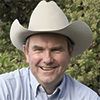Participating in cattle shows builds character and a good work ethic in kids, and many use the proceeds from their animals to help finance a college education.
Big cattle shows like Denver, Houston, Fort Worth, Kansas City, Louisville and San Antonio help educate the general public, and they are a great place for cattlemen to meet and exchange ideas. A lot of business gets done, and they bring in lots of tourist dollars.
And there still isn’t a better way to evaluate an animal’s structural correctness than to look at it. I sat on the auction block as an announcer for a major video company for 20 years and got to see a lot of cattle, and I’ll tell you this, the buyers wouldn’t start bidding until they saw the pictures.
And I don’t care what you say, a rancher still likes to look at good cattle. I believe it was the Greek scholar Anonymous who said, “The eye of the master still fattens his or her cattle.”
On the other hand, I am reminded of another old saying also credited to Anonymous: “They stopped judging chickens when they learned how to count eggs.” There are so many other tools we have to evaluate cattle today that are much more accurate and consistent, and I worry EPDs and DNA data have almost turned cattle shows into their dog show equivalent.
I also know, from having been a judge, that judges who pass down their decisions with God-like superiority and impartiality would admit when it comes to appraising cattle by their phenotype, your guess is often as good as theirs.
I also wonder if judges can’t be influenced in subliminal ways. I love the old Jerry Palen cartoon of Elmo with a baseball bat in his back pocket and, when the judge passes within earshot, he says, “I sure hope the judge likes my kid’s project.”
I have a friend who is one of the best showmen in the business, and he told me that one year he had two heifers that showed in the same class. Usually, the herdsman will show the best one, and the judges know this, but in this case the inferior heifer was a little hard to handle, so my friend showed it.
“And you wouldn’t believe,” he said, “how many times the judges picked the inferior heifer just because I was showing it.”
My judging team coach, Bill Jacobs, was a popular and proficient judge 30 years ago, and I always playfully accused him of reading all the breed journals to see which animals had been winning before he judged a major show. He insisted he never looked at them, and I’ll admit in all the years of our friendship I never caught him reading one. There was one time, though, I think he was tempted.
Bill was asked to judge the Brangus at a major show but, unbeknownst to those who hired him, he’d never judged eared cattle on a big stage before.
Naturally, Bill was a little nervous, and it didn’t help that we ate dinner together the night before the show. I told him that the next day he was going to judge the winningest Brangus bull in history, and he’d better name him grand champion or he’d never judge another show.
The next day, after every bull class, Bill looked at me for a response, and I always just shook my head in disgust as if he’d really blown it. At this point, he was sweating bullets.
In the final class, the 2-year-old bulls, much to my surprise, the best bull I think I’d ever seen in my life, WSR Rocky Joe 650, walked into the ring, and Jacobs got a huge smile on his face. A blind man who knew nothing about cattle could have found him.
Bill died a few years back, and I’ve always regretted I never got the chance to tell him I’d made my whole story up just to make sure he didn’t sleep a wink before the big show. ![]()









